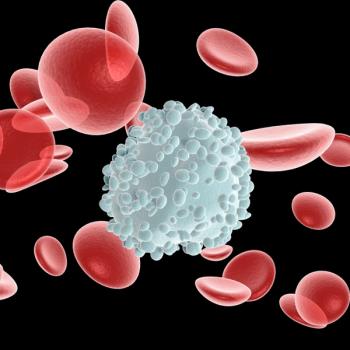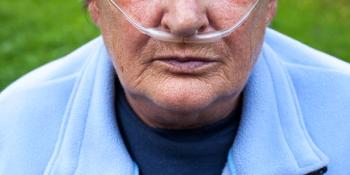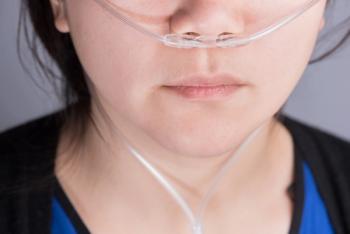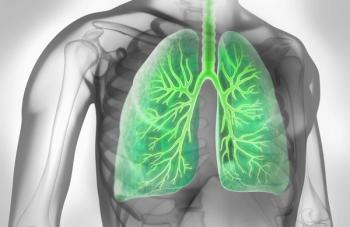
Measures of metabolism and energy expenditure did not appear to be associated with brown adipose tissue activation in patients with emphysematous chronic obstructive pulmonary disease (COPD).

Measures of metabolism and energy expenditure did not appear to be associated with brown adipose tissue activation in patients with emphysematous chronic obstructive pulmonary disease (COPD).

Many patients with chronic obstructive pulmonary disease (COPD) do not believe their cases warrant emergency department care.

This new study from Spain investigated risk factors for COPD among individuals without a smoking history.

Patients with high eosinophil counts appeared to benefit from inhaled corticosteroid (ICS) therapy for chronic obstructive pulmonary disease (COPD), while those with low counts did not.

However, the differences did not translate into an increased or decreased death rate among the cohort.

A small proportion of patients have symptoms of both asthma and chronic obstructive pulmonary disease. A new report suggests there might be an intermediate phenotype.

Two common models, the CURB-65 and BAP-65, had low predictive value in determining which patients with pneumonic chronic obstructive pulmonary disease would not survive.

Investigators analyzed 12 categories of workplace agents, but only the composite category of pesticides was found to be linked with developing chronic obstructive pulmonary disease.

A lack of relationships with pulmonary rehabilitation providers and provider perceptions about patient acceptance serve as limiting factors, new research shows.

The screening tools were found to be feasible measurements and took just 7.6 minutes to complete on average.

Patients whose endurance increases will likely have a higher quality of life and ability to carry out daily functions, the authors said.

Evidence suggests higher levels of iron in pulmonary macrophages heightens the risk of infectious exacerbations.

The research suggests a computed tomography-readable biomarker could help clinicians better understand individual cases of chronic obstructive pulmonary disease.

The 30-day readmission rate among patients receiving post-hospitalization at-home interventions was roughly half the rate of a control group.

As noninvasive ventilation grows in popularity, new research examines when the therapy works, and when clinicians should be cautious.

The study points to the challenges of treating chronic obstructive pulmonary disease in a remote region in a country with a high smoking rate.

The most-read chronic obstructive pulmonary disease (COPD) articles of the year covered use of inhaled corticosteroids, palliative care for advanced COPD, and off-label prescribing of COPD therapies.

With legalization of cannabis across much of the United States and all of Canada, Don Sin, MD, FRCP, MPH, a professor of respiratory medicine at the University of British Columbia and head of the Centre of Heart Lung Innovation, St. Paul’s Hospital, has concerns about the effect of wider cannabis usage on chronic obstructive pulmonary disease (COPD) in future decades.

Don Sin, MD, FRCP, MPH, a professor of respiratory medicine at the University of British Columbia and head of the Centre of Heart Lung Innovation, St. Paul’s Hospital, discusses future possibilities for the prevention of chronic obstructive pulmonary disease (COPD) using new biomarker discoveries and genomic technology advancements.

Interest in the use of digital inhalers is growing, as they may provide real-world evidence about how patients monitor and treat their chronic obstructive pulmonary disease (COPD) and asthma at home, but additional questions need to be answered, according to a recent review.

High-flow nasal therapy overcomes some of the barriers associated with noninvasive ventilation, making the novel support beneficial for patients with acute exacerbations of chronic obstructive pulmonary disease (COPD).

The role that eosinophilic chronic obstructive pulmonary disease (COPD) plays in the pathogenesis of COPD is not well understood, given the lack of evidence about the subject.

The prevalence of chronic obstructive pulmonary disease (COPD) underdiagnosis, false diagnosis, and treatment in the primary care setting is high and often inconsistent with Global Initiative for the Chronic Obstructive Lung Disease (GOLD) guidelines.

Investigators anticipate the results will help physicians tailor treatment methods for patients with chronic obstructive pulmonary disease (COPD) and help to better understand the demographic and clinical implications on peak inspiratory flow.

Blood eosinophil count is a promising biomarker and example of the pathway toward precision medicine in chronic obstructive pulmonary disease (COPD), said Don Sin, MD, FRCP, MPH, a professor of respiratory medicine at the University of British Columbia and head of the Centre of Heart Lung Innovation, St. Paul’s Hospital.

259 Prospect Plains Rd, Bldg H
Cranbury, NJ 08512
© 2025 MJH Life Sciences®
All rights reserved.
